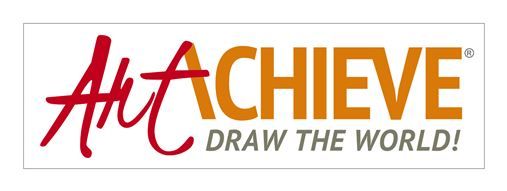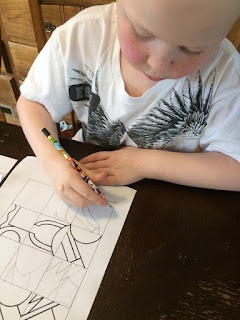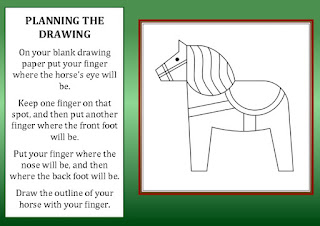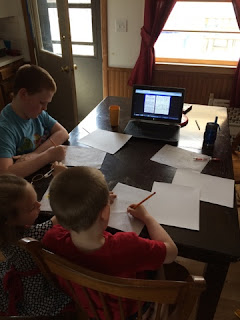
We were given the ArtAchieve lessons for the Entire Level II for this review, and the first thing that I did was look over their Tips for Teachers -- which are great. Then I had a look at the lessons, and decided to start with one of the free art lessons they offer. It is likely that my oldest could have jumped right in, but I knew that the younger kids would want to participate, and I thought that Dragon(6) would particularly benefit from having this type of basic instruction.
Dragon doesn't observe closely. He's the kid that can't find his shoes lying in the middle of an otherwise clear floor, and I've been looking to use art to help him learn to observe and pay attention to the world around him. This has been a little bit if a tough sell, because, not being naturally good at observing, art is often frustrating to him. This lesson was perfect for that. It's all about learning to observe basic lines in a piece of reference material, and then faithfully reproduce them. They've got some cool examples from a Polish church where they've used simple geometric shapes to great effect. Once he learned to see the lines, you could see him starting to gain confidence. His first effort was fast and sloppy, and he wanted to quit. I encouraged him to keep going, "If you go fast and sloppy, of course it's not going to look like the model. But look. This is half a circle. It starts here and goes to there. You can draw that, easy." And he could. And once he had a starting place, he could see how the rest of the lines could be added, and he gained confidence quickly. It was wonderful to watch. It worked out exactly the way that I'd hoped when we'd started doing the "copy the boxes" exercise that is the backbone of the lesson.
Choosing the second lesson was kind of funny: I asked the boys what they wanted to do and they kind of hemmed and hawed, and finally Peanut(4) spoke up and said, "I want to do the horsey!" So I started helping her... and as I suspected would happen, pretty soon the boys were interested and participating, too. Once again, Dragon's hang up was that it looked too hard: he didn't think he could do any of the projects. But there was another copy the boxes page for the warm-up, which included most of the lines in the project. Because he'd done one of those before, he attacked it with confidence -- and then I pointed out that he had drawn nearly the whole horse, just in pieces, and he could definitely handle the real project. He settled down and started enjoying himself. Those warm-up exercises are a great way to build the kids' confidence in doing projects that look intimidating, but really aren't so bad!
 |
| Top: Dragon, Mom. Bottom: Peanut, Hero. |
One thing that I really like about this program is that it gives a lot of support to the student's development of proportion. We quickly learned that it's really important to read the slides before just diving in. Some of them are directions, like this one, that help support proportion and teach planning the use of your paper.
Additionally, they show how to find and use imaginary lines and "planning dots" to guide where to put your final lines. I love that they take the time to show how to see what you are doing before you do it; this kind of careful observation is key to being able to draw well -- and the slides are doing all the heavy lifting, so it's ok if mom thinks she has "no artistic talent" (which usually means that she just hasn't learned how-- if you can write your name you can learn to draw because drawing happens in the eye much more than the hand).
The directions were so clear that even the four year old was able to draw a recognizable horse, which she was really excited about. She had some help getting started: I helped quite a bit with the head to the point where the slide above is, and then she completed the drawing entirely on her own: I helped her to understand the directions, but she did the work.
Each lesson has a fair amount of extra Cross Curricular Connections to go with it, and I was particularly interested in the things included in this lesson about the Swedish Dala Horse, because we have a lot of Swedish ancestry on my mom's side. Knowing that our ancestors may have made horses similar to these for their children made doing the project extra fun, and when we looked at the extra study materials, I did so with an eye toward highlighting things that would support that sense of connection to our own past. We actually ended up doing so much with the extras, and having so much fun with it that they got their own post.
 We also worked on doing some Polish Szopka drawings. This was a more difficult project, and I didn't get nearly as many pictures of it, partly because I was concentrating much more on doing my own work and helping the kids do theirs. But it's so cool to see the kids learn how to see, and how to plan their drawings, and see how their art is maturing and their confidence growing along with it. We got interrupted before we finished (company came over), but Dragon kept going, working from memory, and really did a pretty credible job, particularly considering where he was at when we started this course. I'm really pleased with the way that his skills have been developing, and we'll continue these lessons even after the review, not only because the projects are fun, but also because the kids are enthusiastic and they're all developing some great skills to improve their art.
We also worked on doing some Polish Szopka drawings. This was a more difficult project, and I didn't get nearly as many pictures of it, partly because I was concentrating much more on doing my own work and helping the kids do theirs. But it's so cool to see the kids learn how to see, and how to plan their drawings, and see how their art is maturing and their confidence growing along with it. We got interrupted before we finished (company came over), but Dragon kept going, working from memory, and really did a pretty credible job, particularly considering where he was at when we started this course. I'm really pleased with the way that his skills have been developing, and we'll continue these lessons even after the review, not only because the projects are fun, but also because the kids are enthusiastic and they're all developing some great skills to improve their art.
The one thing that is tricky with this program is getting it set up in our space so we can all see: the lessons are slideshows (they have a video format, too), and the slides are very step-by-step, so you can see exactly what you're supposed to add, and they also do a great job of teaching how to see like an artist. My kids love it. Which means that everybody wants to play, regardless of who the lesson is for, officially. This creates some logistical problems for us: my laptop is usually docked on my computer desk, and I dislike taking it unless absolutely necessary, but my desk can't handle 3 or 4 people all crowding around to see the lessons. I've taken the laptop to the table several times anyway, but we haven't done as much with this program as we would if the logistics were easier for getting the lessons to the kitchen table. It's not a huge problem, and the lessons are well worth the effort of moving the computer to the other room. But having a plan for where you're going to present these is probably good. If I had only a desktop system, which would leave us tied to the computer desk, this course would have been much more difficult to use for a group, and I feel like there was a lot of benefit from doing it as a group where we could encourage each other and the whole group benefited from questions and observations that everybody made.
When I asked them to tell me what they think about ArtAchieve, this is what my kids had to say about it:
The "connecting dots" he's talking about are tiny dots that the program has you put in to help plan where the lines are going to go, in order to help you get the proportions right, and I agree - that was a great feature, one that I will probably also carry forward in my drawing.
Hero(10): Patience! Patience, patience, patience. I always feel like I want to run through the drawings fast and furious, but I learned that it's easier to be patient with yourself. I really liked some of the tutorials they came up with. The connecting dots were really helpful.
Dragon(6): I like how it's not a video. I like that you're able to walk away from it, and you don't miss anything. I learned how to draw a ton of things. I even learned how to use a ruler to make extremely straight lines.
Because we used the slideshow version, we never had to pause, or try to find the right place to back up and look at something again, which was really nice. I agree: navigation through the lessons was simple and straightforward and very user-friendly.
Peanut(4): I liked that we painted the horse.
I was pretty impressed with her and with the lessons. These lessons are intended for kids who are much older than her four years, and she had very little help with this one, since I was trying to get some dinner made before we all went to Scouts for the evening. But they are so so well structured that she could do it, now that she'd already done one with help. I tried to persuade her to do watercolor, but since we'd used acrylics the first time, she wanted those same paints the second time. As a result, a lot of her cute details got obscured when she painted it.
Overall, these were a great fit for our family, and I'm looking forward to finishing our current project, and the kids have already picked out which one they want to do after that. Good times!
To read more reviews on ArtAchieve, and to see how other families used it in their homeschool, please click the link below:










No comments:
Post a Comment